Famous Residents of Binghamton's West Side
The West Side was once home to one of the world's greatest playwrights, a famous inventor, and a family of entrepreneurs.
Rod Serling
 Rod Serling is arguably Binghamton's most famous son. Rodman Edward
Serling was born on Christmas Day, 1924, in Syracuse, New York ("a
Christmas present that was delivered unwrapped," as he would later
say). Although he was not born in Binghamton, and lived in a number of
cities in later life, he always remembered Binghamton as his home town.
From 1926 to 1944, his family lived on the West Side at 67 Bennett
Avenue, and later moved to an apartment on Chapin Street. Rod attended
Hamilton Elementary Grade School, West Junior High School, and
Binghamton Central High School (where he was the editor of Panorama,
the school newspaper). He joined the armed forces during World War II
on the day he graduated from high school in 1942. During basic
training, he earned extra money by boxing, winning seventeen matches.
During active duty, he served as a paratrooper in the Pacific,
surviving 40 jumps. After the war, he attended Antioch College, married
his wife, Carolyn, in 1946, and worked as a staff writer for radio
station WINR in Binghamton, and later WLW in Cincinnati, Ohio. Writing
scripts for plays on his own time, he became successful enough to move
to Westport, Connecticut, in 1954, making a living solely on his writing
ability.
Rod Serling is arguably Binghamton's most famous son. Rodman Edward
Serling was born on Christmas Day, 1924, in Syracuse, New York ("a
Christmas present that was delivered unwrapped," as he would later
say). Although he was not born in Binghamton, and lived in a number of
cities in later life, he always remembered Binghamton as his home town.
From 1926 to 1944, his family lived on the West Side at 67 Bennett
Avenue, and later moved to an apartment on Chapin Street. Rod attended
Hamilton Elementary Grade School, West Junior High School, and
Binghamton Central High School (where he was the editor of Panorama,
the school newspaper). He joined the armed forces during World War II
on the day he graduated from high school in 1942. During basic
training, he earned extra money by boxing, winning seventeen matches.
During active duty, he served as a paratrooper in the Pacific,
surviving 40 jumps. After the war, he attended Antioch College, married
his wife, Carolyn, in 1946, and worked as a staff writer for radio
station WINR in Binghamton, and later WLW in Cincinnati, Ohio. Writing
scripts for plays on his own time, he became successful enough to move
to Westport, Connecticut, in 1954, making a living solely on his writing
ability.Rod's career blossomed during the "Golden Age" of television in the 1950's. He wrote plays for the Armstrong Circle Theatre, Kraft Television Theatre, the U.S. Steel Hour, and Playhouse 90. He won the Emmy award for Requiem for a Heavyweight, the first original 90-minute drama ever written expressly for television. He went on to win six Emmy awards. In 1959, he created the hugely successful television series The Twilight Zone, which aired for five years. He also wrote the screenplays for the movies Seven Days in May and Planet of the Apes.
Rod Serling's connection to the West Side is most strongly expressed in his Twilight Zone episode Walking Distance, the fifth show of the first season, which aired on October 30, 1959. In this episode, the character Martin Sloane (played by Gig Young) comes back to his home town and slips 25 years into the past to his childhood, meeting his younger self and his parents. He visits a park where he carves his initials into the bandstand and rides the carousel. These events are modeled after things that the young Rod Serling did in Recreation Park. (Local lore has it that Mr. Serling's initials were removed during a restoration project).
Rod Serling spent the later years of his life in Interlaken, on Cayuga Lake, where he taught writing at Ithaca College. He died of complications during heart surgery on June 28, 1975. He was 50 years old.
 Rod Serling's legacy lives on in Binghamton. In 1995, the Rod Serling
School of Fine Arts opened at Binghamton High School. He was honored
with the first star in Binghamton's Walk of Fame. An official New York
State bronze plaque in front of Binghamton High School acknowledges his
attendance there. A bronze plaque installed in the floor of the
bandstand in Recreation Park commemorates Walking Distance. A permanent
memorial exhibit, Day of a Playwright - Rod Serling, opened at The
Forum theater in 1985. The Rod Serling Memorial Foundation promotes his contributions to the arts and humanities. His mentor from West Junior High School,
Helen Foley, was honored with the naming of the Helen Foley Theater at
Binghamton High School. And, on August 11, 2009, the United States Postal Service released its Early TV Memories sheet of 20 stamps, one of which was dedicated to The Twilight Zone series and bore the likeness of Rod Serling.
Rod Serling's legacy lives on in Binghamton. In 1995, the Rod Serling
School of Fine Arts opened at Binghamton High School. He was honored
with the first star in Binghamton's Walk of Fame. An official New York
State bronze plaque in front of Binghamton High School acknowledges his
attendance there. A bronze plaque installed in the floor of the
bandstand in Recreation Park commemorates Walking Distance. A permanent
memorial exhibit, Day of a Playwright - Rod Serling, opened at The
Forum theater in 1985. The Rod Serling Memorial Foundation promotes his contributions to the arts and humanities. His mentor from West Junior High School,
Helen Foley, was honored with the naming of the Helen Foley Theater at
Binghamton High School. And, on August 11, 2009, the United States Postal Service released its Early TV Memories sheet of 20 stamps, one of which was dedicated to The Twilight Zone series and bore the likeness of Rod Serling.Edwin A. Link, Jr.
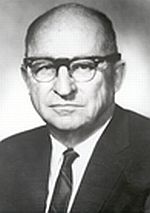 Edwin A. Link, Jr. was born in Huntington, Indiana, on July 26,1904 and
moved to Binghamton with his parents in 1910. The family lived at 86 Riverside Drive on the West Side in a home designed by noted architect C. Edward Vosbury. His father founded the
Link Player Piano and Organ Company and young Ed Link spent his youth
working in the family factory. In his early 20's, he obtained a pilot's
license. His experimentation with organ parts and his love of flying
led to his creation of a rudimentary flight simulator in 1929. During
the 1930's, Ed and his brother formed the Link Flying School and gave
flying lessons as a part-time business. In 1931, Ed married Marion
Clayton, a Binghamton newspaper reporter, and moved to their new home at 10 Avon Road. Ed continued to refine his
simulator and eventually made sales of his "blue box" trainer to the
Army Air Corps in 1934. This led to other sales, and Ed formed Link
Aviation Devices, Inc. to handle production. With the onset of World
War II, a huge demand developed for Link's trainers. Eventually,
over 10,000 were produced.
Edwin A. Link, Jr. was born in Huntington, Indiana, on July 26,1904 and
moved to Binghamton with his parents in 1910. The family lived at 86 Riverside Drive on the West Side in a home designed by noted architect C. Edward Vosbury. His father founded the
Link Player Piano and Organ Company and young Ed Link spent his youth
working in the family factory. In his early 20's, he obtained a pilot's
license. His experimentation with organ parts and his love of flying
led to his creation of a rudimentary flight simulator in 1929. During
the 1930's, Ed and his brother formed the Link Flying School and gave
flying lessons as a part-time business. In 1931, Ed married Marion
Clayton, a Binghamton newspaper reporter, and moved to their new home at 10 Avon Road. Ed continued to refine his
simulator and eventually made sales of his "blue box" trainer to the
Army Air Corps in 1934. This led to other sales, and Ed formed Link
Aviation Devices, Inc. to handle production. With the onset of World
War II, a huge demand developed for Link's trainers. Eventually,
over 10,000 were produced. In the early 1950's, Ed sold his company to devote time to his new interest, underwater archeology. Ed and Marion's first explorations were with surface vessels, Sea Diver and Sea Diver II. In the early 1960's, Ed invented his Submersible Decompression Chamber (SDC). That was followed by his four-man submersible vehicle, Deep Diver. In the early 1970's, with J. Seward Johnson, he invented a new submersible, the Johnson-Sea-Link. An unfortunate accident with this vehicle caused the death of Ed's son, Clayton, and two other divers. This accident led to the creation of the Cabled Observation and Rescue Device (CORD), a remotely controlled vehicle.
Ed Link died on September 7, 1981. Just days before his death, the Binghamton Regional Airport (now The Greater Binghamton Airport) was named Edwin A. Link Field. A permanent Edwin A. Link exhibit is featured at the Roberson Museum and Science Center on Front Street. An endowed faculty chair, the Edwin A. Link Organ Music Professorship, exists at Binghamton University. Ed's company changed hands several times and now exists as L-3 Communications' Link Simulation and Training division. On May 3, 2003, Ed Link was inducted into the National Inventor's Hall of Fame.
Ed Link make a lasting contribution to aviation history, and then went on to make equally significant contributions to oceanography and ocean engineering. He made significant explorations of the West Indies and the Mediterranean Sea and created numerous innovations used in undersea exploration vehicles.
The Kilmer Family
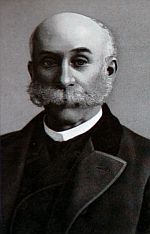 S. Andral Kilmer was born in Cobleskill, New York, on December 19,
1840. He studied under a number of well known doctors and also took
courses at a half dozen medical schools, eventually receiving a Doctor
of Medicine degree and moving to Binghamton. Dr. Kilmer initially
practiced as a visiting physician, making house calls in Binghamton and
the surrounding communities. Besides being a regular physician, Dr.
Kilmer was noted for his numerous patent medicines, consisting of
exotic herbs and roots and a significant percentage of alcohol.
Eventually, he set up a laboratory on Chenango Street to produce his
products. The most famous of these was Dr. Kilmer's Swamp Root Kidney
Liver and Bladder Cure. In 1881, his brother, Jonas, came to
Binghamton to run the business. In 1892, Jonas bought out his brother's
interest in the patent medicine business. Dr. Kilmer progressed toward
an interest in the healing powers of mineral springs. Subsequently he
bought an area near Binghamton containing such springs and built a
sanitarium there. This area, Osborne Hollow near Colesville, was
renamed to Sanitaria Springs. Dr. Kilmer also supposedly had a
treatment for cancer, and built a treatment center on Conklin Avenue in
Binghamton. Dr. Kilmer died at his home at 44 Beethoven Street on
January 14, 1924.
S. Andral Kilmer was born in Cobleskill, New York, on December 19,
1840. He studied under a number of well known doctors and also took
courses at a half dozen medical schools, eventually receiving a Doctor
of Medicine degree and moving to Binghamton. Dr. Kilmer initially
practiced as a visiting physician, making house calls in Binghamton and
the surrounding communities. Besides being a regular physician, Dr.
Kilmer was noted for his numerous patent medicines, consisting of
exotic herbs and roots and a significant percentage of alcohol.
Eventually, he set up a laboratory on Chenango Street to produce his
products. The most famous of these was Dr. Kilmer's Swamp Root Kidney
Liver and Bladder Cure. In 1881, his brother, Jonas, came to
Binghamton to run the business. In 1892, Jonas bought out his brother's
interest in the patent medicine business. Dr. Kilmer progressed toward
an interest in the healing powers of mineral springs. Subsequently he
bought an area near Binghamton containing such springs and built a
sanitarium there. This area, Osborne Hollow near Colesville, was
renamed to Sanitaria Springs. Dr. Kilmer also supposedly had a
treatment for cancer, and built a treatment center on Conklin Avenue in
Binghamton. Dr. Kilmer died at his home at 44 Beethoven Street on
January 14, 1924.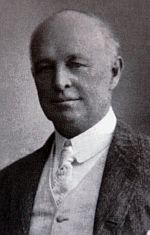 Jonas M. Kilmer, brother of S. Andral Kilmer, was born in Cobleskill,
New York on April 11, 1843. After spending the early part of his
life as a successful merchant in New York City, he came to Binghamton
in 1881 to run the business part of his brother's patent medicine
business as an equal partner. In 1892, he bought out his brother, and
brought in his son, Willis Sharpe Kilmer, as the head of advertising.
Business boomed, and offices of Dr. Kilmer & Company were opened in
other cities in the United States and South America. Jonas and Willis
Kilmer built mansions on adjoining lots on Riverside Drive, designed by
noted architect C. Edward Vosbury. Jonas Kilmer died in 1912.
Jonas M. Kilmer, brother of S. Andral Kilmer, was born in Cobleskill,
New York on April 11, 1843. After spending the early part of his
life as a successful merchant in New York City, he came to Binghamton
in 1881 to run the business part of his brother's patent medicine
business as an equal partner. In 1892, he bought out his brother, and
brought in his son, Willis Sharpe Kilmer, as the head of advertising.
Business boomed, and offices of Dr. Kilmer & Company were opened in
other cities in the United States and South America. Jonas and Willis
Kilmer built mansions on adjoining lots on Riverside Drive, designed by
noted architect C. Edward Vosbury. Jonas Kilmer died in 1912.
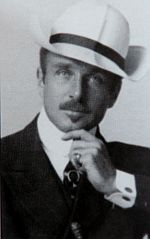 Willis Sharpe Kilmer, son of Jonas M. Kilmer, was born in Brooklyn, New
York on October 18, 1869. He joined his father's patent medicine
business in 1892 as advertising director and was responsible for an
incredible surge in business. In 1904, Willis Sharpe Kilmer founded his
own newspaper, The Binghamton Press, to compete against the existing
paper, The Binghamton Evening Herald.
He built his own skyscraper at 19
Chenango Street to house the paper, with the mandate that it had to be
taller than the Security Mutual building which was going up at the same
time (oddly enough, both buildings were designed by the same local
architect, Truman I. Lacey). Willis Sharpe Kilmer also had a keen
interest in horses. His vast
racing stables, Sun Briar Court, opened in 1918 and stretched along the
south side of Riverside Drive from Lourdes Hospital to the city line at
Margaret Street. His stables had their own racing oval, a clubhouse,
and stalls for 100 horses. Exterminator was the most famous of Willis
Sharpe Kilmer's horses, winning the 1918 Kentucky Derby and going on to
win half of the 100 races of his career. He became one of the most
famous racehorses in history. Willis Sharpe Kilmer died on July 12,
1940.
Willis Sharpe Kilmer, son of Jonas M. Kilmer, was born in Brooklyn, New
York on October 18, 1869. He joined his father's patent medicine
business in 1892 as advertising director and was responsible for an
incredible surge in business. In 1904, Willis Sharpe Kilmer founded his
own newspaper, The Binghamton Press, to compete against the existing
paper, The Binghamton Evening Herald.
He built his own skyscraper at 19
Chenango Street to house the paper, with the mandate that it had to be
taller than the Security Mutual building which was going up at the same
time (oddly enough, both buildings were designed by the same local
architect, Truman I. Lacey). Willis Sharpe Kilmer also had a keen
interest in horses. His vast
racing stables, Sun Briar Court, opened in 1918 and stretched along the
south side of Riverside Drive from Lourdes Hospital to the city line at
Margaret Street. His stables had their own racing oval, a clubhouse,
and stalls for 100 horses. Exterminator was the most famous of Willis
Sharpe Kilmer's horses, winning the 1918 Kentucky Derby and going on to
win half of the 100 races of his career. He became one of the most
famous racehorses in history. Willis Sharpe Kilmer died on July 12,
1940.
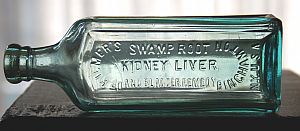 Dr. Kilmer's Swamp Root
medicine is still made, albeit by a
manufacturer not connected in any way with the Kilmer family, and can
be purchased on the Internet (but not in the original style embossed,
collectible bottles). The Kilmer Building still stands at 141
Chenango Street. After many years of being vacant, it has been
extensively restored. The first floor is home to a jewelry
merchant, The Goldsmith, and a restaurant, the Kilmer Brasserie & Steakhouse, with the other floors intended for office
use. Jonas M. Kilmer's home still stands and is now part of Temple
Concord at 9 Riverside Drive. The Press Building, at 19 Chenango
Street, was vacated by the newspaper in 1964 when it moved to Vestal
(with the actual printing being done in Johnson City). The Press
Building is now used for offices, with the major tenants being the law
firm of Coughlin & Gerhart and the Broome County District Attorney's Office. Willis Sharpe Kilmer's The Binghamton
Press became The Evening Press in 1960. In 1985, it merged with
The Sun-Bulletin to become The Binghamton Press & Sun-Bulletin. The
clubhouse from Sun Briar Court still stands on Riverside Drive and is
owned by the Daughters of Charity, an order of nuns who manage Lourdes Hospital. Exterminator
died in 1945. He, along with two of his horse pals, Sun Briar and
Suntica, are buried in a pet cemetery on Gardner Road, about one mile
past Ross Park.
Dr. Kilmer's Swamp Root
medicine is still made, albeit by a
manufacturer not connected in any way with the Kilmer family, and can
be purchased on the Internet (but not in the original style embossed,
collectible bottles). The Kilmer Building still stands at 141
Chenango Street. After many years of being vacant, it has been
extensively restored. The first floor is home to a jewelry
merchant, The Goldsmith, and a restaurant, the Kilmer Brasserie & Steakhouse, with the other floors intended for office
use. Jonas M. Kilmer's home still stands and is now part of Temple
Concord at 9 Riverside Drive. The Press Building, at 19 Chenango
Street, was vacated by the newspaper in 1964 when it moved to Vestal
(with the actual printing being done in Johnson City). The Press
Building is now used for offices, with the major tenants being the law
firm of Coughlin & Gerhart and the Broome County District Attorney's Office. Willis Sharpe Kilmer's The Binghamton
Press became The Evening Press in 1960. In 1985, it merged with
The Sun-Bulletin to become The Binghamton Press & Sun-Bulletin. The
clubhouse from Sun Briar Court still stands on Riverside Drive and is
owned by the Daughters of Charity, an order of nuns who manage Lourdes Hospital. Exterminator
died in 1945. He, along with two of his horse pals, Sun Briar and
Suntica, are buried in a pet cemetery on Gardner Road, about one mile
past Ross Park.